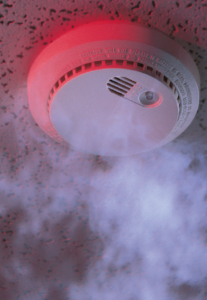Smoke Detectors: Batteries, Monitoring and 10 Year Life
 When first introduced, smoke detectors needed special batteries, but at $10 a piece, dead batteries often remained in place.
When first introduced, smoke detectors needed special batteries, but at $10 a piece, dead batteries often remained in place.
By the 1980s, hard-wired detectors with alkaline battery back-ups ensured functionality at all times. However, in an empty building, a fire would rage until it attracted notice and someone called the local fire department.
The solution to provide the highest level of life-safety is to have smoke detectors connected to a security system that is monitored by a security company’s central monitoring station. A monitored smoke detector is also the best way to minimize property damage.
When to Replace Your Smoke Detectors
National Fire Protection Association research shows that a smoke detector’s effectiveness is diminished after ten years. Based on this, many states have passed legislation requiring smoke-detector batteries to have a 10-year life cycle. The importance of maintaining a functional smoke detector and ensuring it is operating at peak conditions can be underscored by a jarring statistic: The death rate per 100 reported fires is more than twice as high in homes without working smoke alarms compared to homes with working devices. In fact, almost two-thirds of home fire deaths from 2005-2009 resulted from fires in homes without smoke alarms or working smoke alarms.
If your smoke detectors were installed more than a decade ago, it is very important that you have new devices installed as soon as possible. This could be a life-saving decision. If you do not already have an alarm company, Contact Keystone Security Systems today for local service and protection that exceeds your expectations
